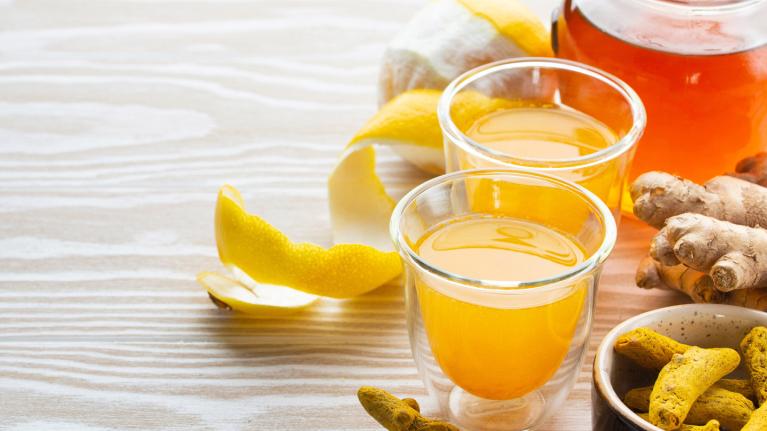
Functional Beverages Are Having Their Moment
Everyone is concerned about immune response these days. That’s the basis for the boom in Enhanced and Functional Beverages. Read more about the trend, here.
The functional and enhanced beverage category is continuing to evolve as the benefits consumers look to from the category shift. As an example, once comprised primarily of energy, sports drinks, and enhanced waters, it is not unusual to find today’s functional beverage aisles brimming with more products that target a wide variety of health concerns.
One of the top benefits consumers are looking for from these drinks today is immunity. Some 58% of consumers in a recent survey said they would be more likely to purchase beverages that support the immune system.1 And the National Restaurant Association (NRA) ranked immunity-boosting snacks fifth and immunity boosting/functional ingredients seventh on its list of the Top 10 Trends for 2022.2
And functional beverages overall? Nearly two-thirds of consumers surveyed in 2021 said they were now more likely to consider drinking them.3
Adventurous consumers, armed with information from social media and other online sources, are more knowledgeable about health and ingredients—from nearby and abroad—than ever before. The result is a willingness to try new functional drinks promising a broader range of benefits.
For example, there are nootropic drinks with ingredients targeted at cognitive function, memory, creativity, or motivation. While nutricosmetic drinks focus on skin health, using vitamins A, D, E, and K, and ingredients like selenium, hyaluronic acid, antioxidant-rich goji berries, or pomegranate juice.4
But expanding into functional beverages need not be as cutting edge. Green tea, for example, remains one of the most common and versatile functional ingredients. And even cocktails or mocktails can be converted into functional drinks with the right ingredients and a little creativity.
Functional beverage users skew toward the wellness- and convenience-oriented channels.5 But Datassential also found restaurants have been making inroads with unique offerings that appeal to consumers and increase check averages for operators.6 Specialty coffee and energy drinks, especially, are quickly growing within the limited-service restaurant space. In fact, energy drinks were the third fastest-growing beverage, by 17% in 2020, in the LSR format.7
Here are some ways operators can take advantage of the growing demand for functional and enhanced beverages:
- One of the hottest and menu-adaptable functional ingredients is turmeric. Add it to smoothies or ginger tea. Turmeric lattes have also been trending recently
- With immunity so important to consumers today, Vitamin C stands out as an attention-grabbing ingredient
- CBD-infused beverages were No. 3 on its list of Top 3 Non-Alcohol Trends for 2022 by the NRA, with nut milks (cashew, pistachio, etc) No. 18
- Color-rich fruits and vegetables are another way to grab attention. And the color of the moment is purple as consumers associate it with healthful properties
- Protein continues to be another on-trend ingredient with consumers associating it with weight loss and energy
- The three LTO beverage concepts with the highest purchase intent from consumers each highlight quality through descriptors such as “real” and “pure-squeezed”9
- Kombucha, the tart, fizzy brew loaded with probiotics has been expanding into innovative flavors like peach, ginger, lemon, apple, blackberry, and vanilla
The fastest-growing functional ingredients on non-alcoholic beverage menus include (ranked in order):
- Turmeric
- Matcha
- Coconut milk
- Agave
- Lemongrass
- Hibiscus
- Kale
- Almond
- Taro root
- Acai
- Avocado10
Differentiate your functional offerings with these global ingredients and beverages:
- Lassi, a blend of yogurt, water, spices, and sometimes fruit, from India
- Lapsang Souchong, a black tea from China
- Genmaicha, brown rice green tea from Japan
- Atole, a hot corn- and masa-based beverage of Mesoamerican origin
- Dragon fruit, a smoothie-friendly ingredient also known as pitaya, native to Mexico and Central America
- Maca root, from Peru
- Taro root, from Asia
- Palo Santo, an edible tree bark native to South America and Mexico
Seen on Menus:
- Toxin Flush Juice with spinach, parsley, apple, lemon, and ginger
- Cozy Immunity Tonic with lemon, ginger, honey, milk thistle, and dandelion
- Herbal Tea Soda with lemongrass, chamomile, spearmint, lavender, marigold, and tangerine
- Matcha Hemp Latte consisting of matcha tea, coconut milk, hemp seed, cinnamon, and maple syrup
- Immunity Booster Shot with ginger, turmeric, apple, lemon, and apple cider vinegar or black pepper
- Super Green Smoothie with frozen banana, cucumber, coconut milk, hemp seed, and spirulina
- New Nestlé® Vitality® Enhanced Cold Beverages support a healthy immune system from vitamins C, B6, and B12. They are also an excellent source of vitamins B3 (Niacin), B5 (Pantothenic Acid), Zinc, and Magnesium. Available in four flavors: Blood Orange Juice with Ginger & Turmeric; Watermelon Raspberry Lemonade; Pomegranate Raspberry White Tea; and Lemon Ginger White Tea, in 32 oz. Hand-Mix Cartons
- 58% of consumers say they’re more likely to purchase beverages that support a healthy immune system, with 22% of them willing to pay more for them than a customary drink11
Sources: 1. Technomic 2020 Beverage Consumer Trend Report. 2. What’s Hot 2022 Culinary Forecast, National Restaurant Association. 3. “Functional Beverages” March 2021, Datassential. 4. Nestlé Professional’s Top 2022 Food and Beverage Industry Trends. 5. Hartman Group: “Functional Food & Beverage And Supplements” 2020. 6. “Functional Beverages” March 2021, Datassential 7. Technomic Ignite Menu Data, Q1 2018-Q1 2020, 212 LSR Operators. 8. What’s Hot 2022 Culinary Forecast, National Restaurant Association. 9. Technomic Beverage Navigator Spotlight, July 2021. 10. The World of Non-Alcoholic Beverages, April 2021, Datassential. 11. Technomic, Beverage Consumer Trend Report, 2020
The information provided is based on a general industry overview, and is not specific to your business operation. Each business is unique and decisions related to your business should be made after consultation with appropriate experts.


